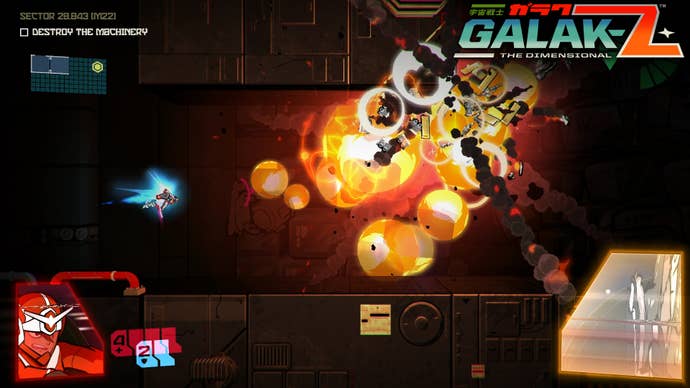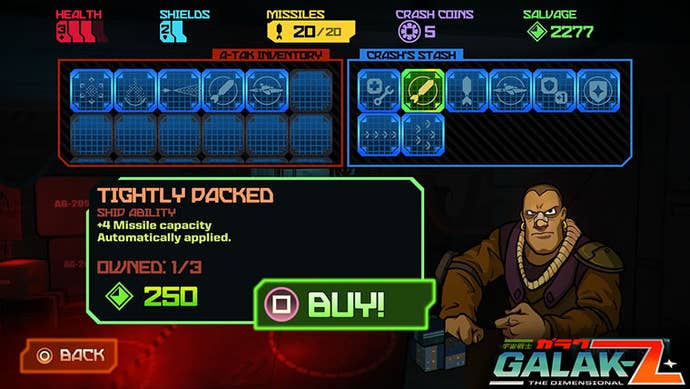Galak-Z PlayStation 4 Review: Super Dimensional Shoot 'Em Up
17-Bit's smartly-designed shoot 'em up is a gem even for those who didn't grow up watching Robotech and Voltron.
This article first appeared on USgamer, a partner publication of VG247. Some content, such as this article, has been migrated to VG247 for posterity after USgamer's closure - but it has not been edited or further vetted by the VG247 team.
Bandai Namco should have used the concept for Galak-Z ages ago. It's probably the best variable fighter game since 1994's Scrambled Valkyrie for the Super Nintendo, even if that has as much to do with Bandai Namco's output as Galak-Z's overall quality. Make no mistake, though - 17-Bit's wonderful little shoot 'em up is a keeper.
Galak-Z puts you in the role of a misfit pilot named A-Tak, who in the grand tradition of mecha anime is the last hope for Earth against a powerful alien empire. Also in the grand tradition of mecha anime, he pilots a prototype mech that is agile, powerful, and extremely durable. This being a video game, though, A-Tak's quest will often end in failure, his shattered helmet floating through space as a digitized voice cackles in the background.

Being a pseudo-roguelike, Galak-Z has something approaching permanent death, requiring that you restart a chapter after succumbing under fire. As a consequence, running through each five mission season is a bit of a gauntlet, with every individual encounter having the potential to become a disaster that leaves you gasping for breath with one point of armor remaining. Though it isn't a roguelike in the traditional sense - there's no identification game and it's possible to earn a continue if you find five Crash Coins - Galak-Z does have that familiar strangling feeling that comes with ever diminishing resources, both health and missiles being precious resources.
I've already written a bit on how hard Galak-Z can be at times, but it bears repeating that this game can be really nasty. The first major difficulty spike hits in Season 2, shortly after you gain the ability to turn into a mech. To progress, you have to learn the best way to approach each enemy ship, get used to abusing environmental hazards, and develop a working knowledge of the upgrades. If you don't, you will eventually be overwhelmed and killed, and that laugh will haunt you back to the title screen.
I'm back and forth on Galak-Z's difficulty balance. It has a pretty nasty learning curve; and as I've written elsewhere, I think a natural drawback of its procedurally generated encounters is that they can't easily be balanced. I'm also split on the decision to reset power-ups from chapter to chapter. In Galak-Z, you can find or purchase a huge number of upgrades for your ship, from better engines to additional health, which are necessary for competing on an equal footing with enemy units. Typically, you can build up a foundation pretty quickly; but by Season 4, the difference in power without upgrades is quite stark. Galak-Z does its best to soften the transition by converting unused Crash Coins to currency to buy some initial upgrades, but it's not quite enough. As much as I understand 17-bit's reasoning in resetting the upgrades from season to season in video game terms (if not in story terms), it's a drag to have to basically start from zero after a successful campaign.
Fortunately, even the vanilla fighter has quite a few moves at their disposal. In fighter mode, you present a tiny target profile, making it possible to dart rapidly about the screen and harrass foes at long range. When you transform into the mech, you can grab foes with your grappling hook and punch them until they explode, throw them against the wall to stun them, or toss exploding barrels at them. You also have a nasty beam saber at your disposal, and though there's some risk in getting too close to an enemy unit, it feels wonderful to slice through a damaged foe. Dicing up an opponent with my beam saber makes me feel like Amuro Ray or Kira Yamatao - a feat that I can't recall a Gundam game ever accomplishing.

The rest of the combat is similarly exhilirating. Movement can feel a bit finicky as you get used to the thrusters, but the controls quickly become second nature. Galak-Z is ostensibly a 2D game, but the dogfights feels surprisingly multi-dimensional as you hammer your boost to evade enemy fighters and either dodge over their shots or block them. That feeling of multi-dimensional combat is further driven home by the realistic space physics, which require you to manage your momentum with the help of well-timed boosts. They can also be used to your advantage, allowing you to cut your engines and drift noiselessly past an enemy formation.
More often than not, stealth is the best course of action in Galak-Z. As in Dark Souls and other famously difficult games, even individual enemies can really mess you up if you're not careful. A Sentinel wielding a beam saber can pop your shields and start whittling away your health with frightening speed. And as you progress, regular units will progressively give away to speedier elites possessing more health and nastier weapons. You'll soon come to recognize individual enemies and their quirks, from the slow but heavily armed Rhinos to the viciously fast and heavily-armed Hammerheads, and by extension, how to deal with them. Sometimes the best way to deal with a particularly powerful opponent is to simply run away.

These encounters, while frustrating at times, lie at the heart of Galak-Z's appeal. They are interesting, require forethought and planning, and help to stave off the sense of repetition that is always in danger of creeping in with Galak-Z's relatively limited set of procedurally-generated tilesets. Even better, they all have individual portraits, taunts, and reactions, and with three different enemy factions in play, they are quite varied as well. Best of all is leading a group of enemies from different factions into one another and watching the fireworks erupt as they fight and taunt one another.
Such moments serve to highlight the amount of thought and attention to detail that has gone into Galak-Z's design. It's enough that I can forgive the pallette-swapped foes that start to creep in later in the game, and the fact that most of the missions can be boiled down to either destroying or capturing an item hidden somewhere in a given level. Galak-Z is a game that thrives on the basis of its individual encounters.
From that standpoint, I find it quite easy to recommend Galak-Z. Taking away its paper doll-like characters, which look as if they've been animated in a flash cartoon from the early 2000s, it's quite an attractive game with marvelous little touches like a pause screen resembling a paused VCR. And while Galak-Z had a comparatively large number of bugs and framerate hitches at launch, they've been smoothed away by a rather large patch that went live this past weekend.
As a mecha fan, I find Galak-Z delightful. It's a love letter to the genre in general, and Macross in particular. Underneath the fan service, though, is a smartly-designed shoot 'em up of the sort that I don't see nearly enough of on consoles these days. Even if you don't particularly like mecha, it's certainly worth a look. Who knows, it may make you a fan.
InterfaceGalak-Z's controls are smartly designed and responsive, which is crucial in a game like this. Pretty much everything well-explained and easy to understand.
Lasting AppealGalak-Z is not an easy game to master, and with some 25 missions split across five seasons, there's plenty of content to keep you engaged.
SoundGalak-Z quickly settles into a much more laid back synth-heavy style that fits with the space setting and helps to underline the action. It's aided by fantastic sound effects.
VisualsThere's a lot to love about Galak-Z's overall look, from the '80s anime-inspired enemies and ships, and it's blessed with detailed explosions and fire.
ConclusionGalak-Z is a smartly-designed, highly enjoyable shoot 'em up that does everything in its power to leverage its '80 mecha anime aesthetic. Frankly, there's not a lot like it on PSN these days. On that basis, it's easy enough to recommend it, but what really pushes it to the next level is the tremendous amount of detail put into the enemy design and the combat. It has a steep learning curve, but mastering it is an extremely rewarding experience. Even if you don't particularly like Macross, it's well worth checking out. It's one of the best shoot 'em ups I've played in ages.


